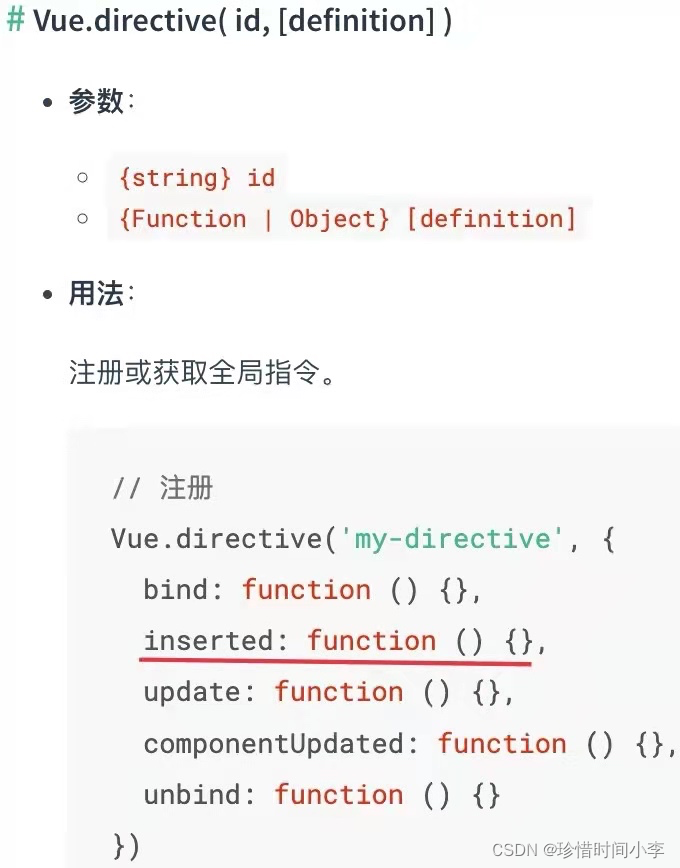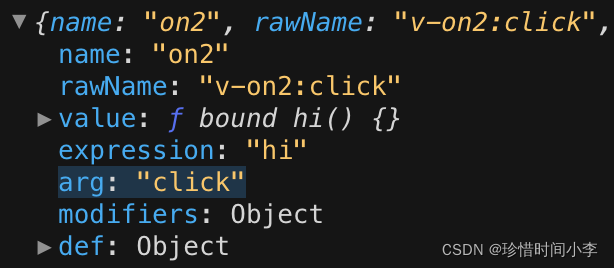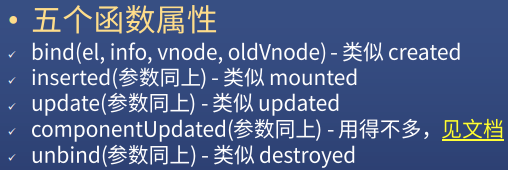Vue构造属性: directives、mixins、extends、provide、inject
1.Directives 指令
2种写法
1’ 声明一个全局指令
Vue.directive('x',directiveOptions)

例子:造出v-x,点击即打印x。
声明指令x,当元素被插入到页面中之后,我们就监听它的click事件。
1.先声明
main.js
Vue.directive('x',{ //单个directive
inserted:function(el){
el.addEventListener('click',()=>{console.log('x')})
},
})
2.再使用x指令
进入App.vue组件
<template>
<img v-x width="25%" src="./assets/logo.png">
<HelloWorld msg="Hello Vue"/>
//让HelloWorld也响应:进入HelloWorld.vue组件添加`<h1 v-x>`,再次点击<h1>控制台就会输出x。
</template>
你可以在任何组件里用v-x了。
inserted你把el放哪个元素上,el就是哪个元素,比如放<img>上,el就是<img>
2’ 声明一个局部指令
v-x只能在该实例中用
new Vue({
...,
directives:{
"x":directiveOptions
}
})
例子: 只能在HelloWord.vue组件里用 x
HelloWord.vue
<template>
<div class="hello">
<h1 v-x>{{ msg }}</h1> //使用
</div>
</template>
<script>
export default {
directives: { //可声明多个directives
'x': {
inserted(el) {
el.addEventListener("click", () => {console.log("x")});
},
},
},
</script>
directiveOptions的其它属性
常用的钩子函数:bind、inserted、unbind
函数接收的参数,都是Vue传给我们的:el、info、vnode、oldVnode
1.el 就是你把v-x绑到哪个元素上去了
2.info 就是除了传元素外,你还传了哪些东西。info包含了很多详细的消息,基本上你要的东西都在第2个参数里。
原文是binding对象:

3.vnode 元素对应的虚拟节点
4.oldVnode 之前的虚拟节点,有可能这个元素是从旧到新
例子: 模仿v-on,自制v-on2指令
new Vue({
directives: {
on2: {
inserted(el, info) {
//console.log(el); 打印出<button>点我</button>
//console.log(info); 打印出一个对象
console.log(info.arg);
el.addEventListener(info.arg, info.value);
},
unbind(el, info) { //unbind用于清理垃圾,删除监听
el.removeEventListener(info.arg, info.value);
}
}
},
template: `
<button v-on2:click="hi">点我</button>
`,
methods: {
hi() {
console.log("hi");
}
}
}).$mount("#app");
addEventListener时无法确定是否是click,因为还有可能是其它事件,比如keyup。此时可以利用第2个参数拿到用户传的事件。用info得到用户传的事件
info拿到的是个对象

当元素被插入到页面中时,我们就监听这个元素的事件和对应的方法。
函数简写不推荐
指令的作用
1.主要用于DOM操作
Vue实例/组件用于数据绑定、事件监听、DOM更新
Vue指令主要目的就是原生DOM操作
2.减少重复
如果某个DOM操作你经常使用,就可以封装为指令
如果某个DOM操作比较复杂,也可以封装为指令
解析
1.主要用于DOM操作
平时在用Vue时从来不做DOM操作,只是改数据,数据自动更新UI。但是我们在实际开发中有时不得不写DOM操作,这时可以把DOM操作封装成一个指令,然后只传个函数给这个指令这样就可以永远不去接触DOM操作了。
new Vue({})一般会传data、methods、钩子函数主要用途就是数据绑定、事件监听、DOM更新。DOM更新不是通过DOM API更新,而是直接通过监听器去更新。如果你要进行DOM操作,就只能用Vue指令,Vue组件和Vue指令各司其职。
mixins 混入
mixins目的也是为了减少重复,就是把一些属性复制到你的组件上。
类比
1.directives的作用是减少DOM操作的重复
2.mixins的作用是减少data、methods、钩子的重复,也就是减少构造函数的重复。
示例
使用mixins减少重复
App.vue
<template>
<div id="app">
<Child1 v-if="child1Visible"/>
<button @click="child1Visible = false">x</button>
<Child2 v-if="child2Visible"/>
<button @click="child2Visible = false">x</button>
<Child3 v-if="child3Visible"/>
<button @click="child3Visible = false">x</button>
<Child4 v-if="child4Visible"/>
<button @click="child4Visible = false">x</button>
<Child5 v-if="child5Visible"/>
<button @click="child5Visible = false">x</button>
</div>
</template>
<script>
import Child1 from "./components/Child1.vue";
import Child2 from "./components/Child2.vue";
import Child3 from "./components/Child3.vue";
import Child4 from "./components/Child4.vue";
import Child5 from "./components/Child5.vue";
export default {
name: "App",
data() {
return {
child1Visible: true,
child2Visible: true,
child3Visible: true,
child4Visible: true,
child5Visible: true
};
},
components: {
Child1,
Child2,
Child3,
Child4,
Child5
}
};
</script>
Child1.vue
<template>
<div>Child1</div>
</template>
<script>
import log from "../mixins/log.js";
export default {
data() {
return {
name: "Child1", //name自己传
};
},
created() {
console.log("Child 1 的 created");
},
mixins: [log],
};
</script>
Child2.vue
<template>
<div>Child2</div>
</template>
<script>
import log from "../mixins/log.js";
export default {
data() {
return {
name: "Child2" //name自己传
};
},
mixins: [log]
};
</script>
Child3.vue、Child4.vue、Child5.vue代码略...
log.js
const log = { //log必须是对象
data() { //2个data会智能合并
return {
name: undefined,
time: undefined
};
},
created() {
if (!this.name) {
throw new Error("need name");
}
this.time = new Date();
console.log(`${this.name}出生了`);
},
beforeDestroy() {
const now = new Date();
console.log(`${this.name}死亡了,共生存了 ${now - this.time} ms`);
}
};
export default log;
mixins的实现思路
五个组件都有构造函数data、created、beforeDestroy,那我们就把公共的抽到一个地方。
步骤
1.新建目录mixins、新建文件log.js,然后将共有的剪切到log.js里。
log.js代码参照上面
2.使用log
Child1.vue代码参考上面
<script>
import log from "../mixins/log.js";
export default {
mixins: [log], //把log里的内容复制到我这里
};
</script>
mixins技巧
选项智能合并文档
也可以使用全局Vue.mixin 但不推荐使用
extends 继承、扩展
extends也是构造选项里的一个选项,跟mixins很像,也是复制减少重复但形式不同。extends更抽象高级,但还是推荐用mixins。
步骤
1.新建文件MyVue.js,这不是Vue组件。
import Vue from "vue"
const MyVue = Vue.extend({ //继承Vue,MyVue就是Vue的一个扩展
data(){ return {name:'',time:undefined} },
created(){
if(!this.name){console.error('no name!')}
this.time = new Date()
},
beforeDestroy(){
const duration = (new Date()) - this.time
console.log(`${this.name} ${duration}`)
},
//mixins:[log] 也可以使用mixins
})
export default MyVue
2.导入+继承
Child1.vue
<template>
<div>Child1</div>
</template>
<script>
import MyVue from "../MyVue.js";
export default{
extends:MyVue,
data(){
return {
name:"Child1"
}
}
}
</script>
extends是比mixins更抽象一点的封装。如果你嫌写5次mixins麻烦,可以考虑extends一次,不过实际工作中用的很少。
provide(提供) 和 inject(注入)
App.vue
<template>
<div :class="`app theme-${themeName} fontSize-${fontSizeName}`">
//同时添加3个class
//注意: :class=""双引号是XML的双引号,不是JS的双引号。``这是JS的引号
<Child1/>
<button>x</button>
<Child2/>
<button>x</button>
<Child3/>
<button>x</button>
<Child4/>
<button>x</button>
<Child5/>
<button>x</button>
</div>
</template>
<script>
import Child1 from "./components/Child1.vue";
import Child2 from "./components/Child2.vue";
import Child3 from "./components/Child3.vue";
import Child4 from "./components/Child4.vue";
import Child5 from "./components/Child5.vue";
export default {
name: "App",
provide() {
return {
themeName: this.themeName,
fontSizeNmae: this.fontSizeName,
changeTheme: this.changeTheme,
changeFontSize: this.changeFontSize
};
},
data() {
return {
themeName: "blue", // 'red'
//blue和red存在themeName里,点击换肤时会切换blue、red
fontSizeName: "normal" // 'big' | 'small'
};
},
methods: {
changeTheme() {
if (this.themeName === "blue") {
this.themeName = "red";
} else {
this.themeName = "blue";
}
},
changeFontSize(size) {
//name在这3个中时下标才会 >= 0,不在下标是-1
if (["normal", "big", "small"].indexOf(size) === -1) {
throw new Error(`wront size: ${size}`);
}
this.fontSizeName = size;
}
},
components: {
Child1,
Child2,
Child3,
Child4,
Child5
}
};
</script>
<style>
.app {
font-family: "Avenir", Helvetica, Arial, sans-serif;
-webkit-font-smoothing: antialiased;
-moz-osx-font-smoothing: grayscale;
text-align: center;
color: #2c3e50;
margin-top: 60px;
}
//换肤的实现是用CSS
//如果一个元素能同时满足app和theme-blue,就设置button为蓝色
.app.theme-blue button {
background: blue;
color: white;
}
.app.theme-blue {
color: darkblue;
}
.app.theme-red button {
background: red;
color: white;
}
.app.theme-red {
color: darkred;
}
.app.fontSize-normal {
font-size: 16px;
}
.app button {
font-size: inherit;
}
.app.fontSize-small {
font-size: 12px;
}
.app.fontSize-big {
font-size: 20px;
}
</style>
流程
1.新建ChangeThemeButton组件:新建ChangeThemeButton.vue
ChangeThemeButton.vue
<template>
<div>
<button @click="changeTheme">换肤</button>
<button @click="changeFontSize('big')">大字</button>
<button @click="changeFontSize('small')">小字</button>
<button @click="changeFontSize('normal')">正常字</button>
</div>
</template>
<script>
export default {
};
inject: ["themeName", "changeTheme", "changeFontSize"]
};
</script>
Child1.vue
<template>
<div>Child 1
<change-theme-button/> //这样也能找到组件,Vue会自己找
</div>
</template>
<script>
import ChangeThemeButton from "./ChangeThemeButton.vue";
export default {
components: { ChangeThemeButton }
};
</script>
2.App.vue完善需求实现切肤
代码参考上面App.vue
3.provide + inject
App组件(App.vue)只要切换自己的“data的themeName值”就能换肤,那如何在按钮里(ChangeThemeButton组件)改变App的data?自己只能改变自己的data,怎么才能改变别人的data?用provide实现改变别人的data。
(1)provide:在提供数据的地方写provide,提供给别人改
App.vue
<script>
export default {
name: "App",
provide() {
return {
themeName: this.themeName, //提供给别人用或改
fontSizeNmae: this.fontSizeName, //提供给别人用或改
changeTheme: this.changeTheme, //提供给别人用或改
changeFontSize: this.changeFontSize //提供给别人用或改
};
},
(2)inject:把别人提供的东西注入到我的组件来,使用provide
ChangeThemeButton.vue
<template>
<div>
<button>当前主题色:{{themeName}},换肤</button>
</template>
<script>
export default {
inject: ["themeName"]//注入
};
</script>
注意:provide提供的是字符串的复制品,拿到的是string,不能改,应该把改的函数传过来,拿到函数的引用调用它就行(changeTheme)。
App.vue
provide() {
return {
themeName: this.themeName,//提供给别人用或改
changeTheme: this.changeTheme,//提供给别人用或改
};
},
methods: {
changeTheme() {
if (this.themeName === "blue") {
this.themeName = "red";
} else {
this.themeName = "blue";
}
},
ChangeThemeButton.vue
<template>
<div>
<button @click="z">当前主题色:{{themeName}},换肤</button>
</template>
<script>
export default {
inject: ["themeName", "changeTheme"],
methods:{
z(){
this.changeTheme()
}
}
};
</script>
字符串拿来时已经复制了,改复制品没用,也可以用对象的引用,但不推荐。因为当这样做的人多了之后就没法控制量了,变量被到处改,无法知道变量处于什么状态,容易失控。
知识点
1.:class=""双引号是XML的双引号,不是JS的双引号。
``这是JS的引号
<div :class="`app theme-${themeName} fontSize-${fontSizeName}`">
解析:第1个class是app。第2个class是theme-${themeName},blue和red存在themeName里。
第3个class是fontSize-${fontSizeName}
2.CSS选择器
<div :class="`app theme-${themeName}`">同时设置多个class
.app.theme-blue{ background:blue }
//如果一个元素同时满足这2个选择器,一个class为app,一个class为theme-blue,那么就设置为blue
.app.theme-blue button{ background:blue }
//如果一个元素能同时满足app和theme-blue,那么它里面的button就是蓝色
.app .theme-blue
//如果app里面有theme-blue

